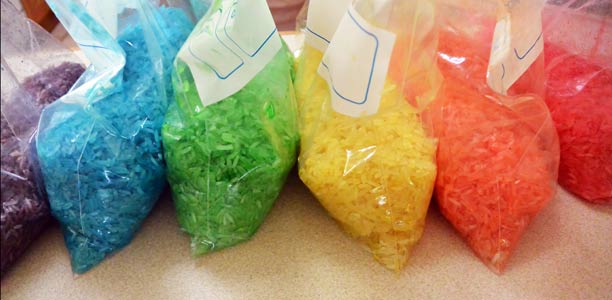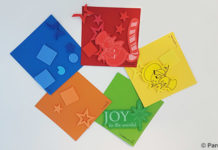Age
0-8 years. Most of these games and activities are suitable for toddlers and preschool children. Sensory play games like pouring and scooping are great for babies and toddlers. The weighing and measuring activity and the more complex art ideas are more suitable for children in their early years of primary school.
Duration of activity
Colouring rice for play takes just a few minutes (although you’ll need to wait 24 hours before your child uses it for play). It can be used to play a range of activities and will provide your child with hours of fun and learning.
Materials/equipment
 Rice (as much or as little as you would like to colour)
Rice (as much or as little as you would like to colour)- Snap lock bags
- Food dye in the colours you would like to use
- Glitter (optional)
- Cling wrap
- Alcohol-based, no-rinse hand sanitiser
Cost
You probably already have most of the materials you need to make coloured rice at home. If not, they can be purchased cheaply at the supermarket.
Preparation
- Put as much rice as you would like to colour in a snap lock bag. If you are making several different colours you will need a separate snap lock bag for each colour.
- Add a few squirts of hand sanitiser. The more rice you wish to colour the more hand sanitiser you will need to add.
- Ask your child which colour they would like to dye the rice. If they choose a secondary colour (one that needs to be made by mixing primary colour red, blue and yellow) ask them which colours they need to add to get the colour they desire (e.g. red and blue will make purple).
- Add 10-20 drops of food colouring- the more you add the more vibrant the colour of the rice will be. Larger quantities of rice will require more food colouring.
- Snap the bag closed and mix well until the rice absorbs the colour. Your child will probably enjoy doing the mixing, just make sure the bag is properly snapped shut before they start. If the colour is not as vibrant as you want, add some extra food dye.
- Open the bag and leave to air dry in a dry room for 24 hours.
- Store each different colour rice in a separate, airtight container.
Games and activities to play with coloured rice
Rice box (instead of a sand box)
 Make enough rice to fill a box that your child can use for scooping and pouring. Add different types of scoops and containers to the box for your child to experiment with. It’s a great way to reuse containers and packaging that would otherwise end up in the bin. For example, old kitchen paper towel rolls and toilet rolls make great pipes for rice to be poured through. Small and large containers (e.g. old yoghurt tubs) can be used for either scooping or catching the rice. Kitchen utensils like measuring spoons, colander, different sized funnels, whisk or fork for raking also make playing with rice more fun and educational.
Make enough rice to fill a box that your child can use for scooping and pouring. Add different types of scoops and containers to the box for your child to experiment with. It’s a great way to reuse containers and packaging that would otherwise end up in the bin. For example, old kitchen paper towel rolls and toilet rolls make great pipes for rice to be poured through. Small and large containers (e.g. old yoghurt tubs) can be used for either scooping or catching the rice. Kitchen utensils like measuring spoons, colander, different sized funnels, whisk or fork for raking also make playing with rice more fun and educational.
Children’s toys like a dump truck or mini windmill which the rice can be poured onto also maximise the enjoyment and education your child will get from this game.
Sensory play-touch
 Children will enjoy the many sensations that touching rice provides, whether they are dipping their hands into it or feeling it poured over their fingers. Start stimulating their senses as you colour the rice. Let your child feel the dry rice and compare it to the feel of the rice when it is wet in the snap lock bag. Feel the rice again once it has dried. Once the rice is ready to play, you can allow them to explore their sense of touch in many other ways, for example by:
Children will enjoy the many sensations that touching rice provides, whether they are dipping their hands into it or feeling it poured over their fingers. Start stimulating their senses as you colour the rice. Let your child feel the dry rice and compare it to the feel of the rice when it is wet in the snap lock bag. Feel the rice again once it has dried. Once the rice is ready to play, you can allow them to explore their sense of touch in many other ways, for example by:
- Spreading a thin layer of rice on a flat surface and getting your child to run their hand lightly over it, then later scoop the rice together;
- Pouring rice over their hands or other body parts. Use different quantities of rice, pour it from containers with different sized openings and from different heights. You could shake the rice out little by little or turn the container upside down so it all rushes out.
- Comparing the feel of the dry coloured rice to a bit of leftover cooked rice.
- Placing a layer of rice in a shallow box so that your child can press their hands and fingers into it to make shapes.
- Letting them walk on a coloured rice path (but make sure they wash their feet properly first or make some rice just for walking on!).
Sensory play-hearing
Making music and sound with coloured rice is a great way to allow children to explore their sense of hearing. Making music is easy and there are lots of ways to do it. For example you could:
- Make the sound of rain drops pattering on a tin roof by shaking grains gently onto a metal baking tray. An old spice jar with large holes makes a good shaker.
- Fill plastic containers and tins with different quantities of rice and shake them in different ways to make different sounds. Compare the noise the rice makes when the container is closed with the lid or opened, or when it is shaken gently or vigorously.
- For older children try shaking the closed jars to the beat of their favourite song or a popular nursery rhyme.
- For babies, put a bit of coloured rice in round transparent plastic jars (e.g. and old peanut butter jar with the label removed). Add a small toy that your baby will see through the grains of rice. Your baby will enjoy hearing the noise of the rice as they push the jars around the floor.
Colour games
 If you have made several different colours of rice, you’ve created a game that will provide your child with a wealth of opportunities to learn about colour. Mix together a small quantity of different coloured rice and ask your child to pick up a single grain of red rice (or whatever colour you choose). Get them to pick up grains of all the different colours.
If you have made several different colours of rice, you’ve created a game that will provide your child with a wealth of opportunities to learn about colour. Mix together a small quantity of different coloured rice and ask your child to pick up a single grain of red rice (or whatever colour you choose). Get them to pick up grains of all the different colours.
If your child is old enough to sit down and concentrate for a while, give them a container for each different rice colour, and ask them to sort the grains of different colours into the containers.
For older children, get them to pick out grains of rice that could be mixed together to make a secondary colour (e.g. a red grain and a yellow grain to make an orange grain).
Art games
Use coloured rice to create beautiful pictures and patterns. Start by drawing the outline of the picture or pattern you would like to make rice art out of. Or you could use printable shape worksheets, for example to teach your children about shapes at the same time. Older children will enjoy drawing their own design. Younger children may enjoy just sticking rice to a blank piece of paper, more than trying to create a pre-drawn picture. When the picture is ready spread glue on the paper and sprinkle rice on top. If your child is making a picture or pattern, try spreading glue only on specific parts of the pattern (e.g. all the areas you want to stick blue rice to) at first. When the first colour rice is stuck on, glue other parts and sprinkle with a different colour rice, continuing until the pattern is complete. Old kids may also enjoy making small, fiddly patterns by sticking rice grains onto the paper one at a time.
Role play cooking
Let your child pretend to cook the coloured rice. If they have a play kitchen, use the utensils that come with that. If not, scavenge a small pot, measuring cups and other utensils from your kitchen and draw some circles on top of an old cardboard box to make a stove. Cooking role plays are a great opportunity to remind your child about the importance of hand washing, for example before cooking and serving the food.
Depending on your child’s age there are many other activities your can incorporate into the role play. For example, you could measure the rice out before cooking it, using either measuring cups or a kitchen scale, depending on which utensils you would like them to use. When the rice is cooked your child could serve it pretending to be a mum or dad giving their children food. Or they could pretend they are in a restaurant and pack it into a container and sell it to a customer. You could use pretend money to buy the cooked rice from your child.
Treasure hunt game
Fill a box with coloured rice (you’ll need to use quite a bit of rice for this). Hide small objects in the rice, for example a pencil or other stationary items, small toys, marbles, hair elastics or other small things your child likes to play with. Make a list of the things you have hidden in the rice. Give your child the box and tell them that there are special treasures hidden inside and they need to find them by dipping their hands into the rice. Preschoolers will probably enjoy this game more if you give them a pair of tongs or a scoop to pick the objects out with. As they find the items talk about what they have found, for example its colour and what it is used for. Keep instructing them to find objects in the rice until they have found all the items on the list.
Weighing and measuring games
 Older children will have a lot of educational fun weighing and measuring rice. Start by measuring the coloured rice into containers of different shapes and sizes. Talk about how much rice fits in each and which ones are bigger and smaller. For example start with a cup of rice and see which containers are too small to fit the entire cups and which ones are so big that there is still space in them after adding a cup of rice. Then get your child to put various quantities of rice into different containers and guess which one is heaviest (or for older children who are already familiar with weights, ask them to guess how many grams the rice in the container weighs). Weigh them using a kitchen scale.
Older children will have a lot of educational fun weighing and measuring rice. Start by measuring the coloured rice into containers of different shapes and sizes. Talk about how much rice fits in each and which ones are bigger and smaller. For example start with a cup of rice and see which containers are too small to fit the entire cups and which ones are so big that there is still space in them after adding a cup of rice. Then get your child to put various quantities of rice into different containers and guess which one is heaviest (or for older children who are already familiar with weights, ask them to guess how many grams the rice in the container weighs). Weigh them using a kitchen scale.
Tips
- Use the food dye which is marked for use on ‘play dough’ as this is specially designed to produce a vibrant colour (available from most supermarkets in the baking aisle).
Extension activities
- As you make the coloured rice, ask your child to count the drops of food colouring. For older children, get them to guess how much the rice they will colour weighs, then weigh it on your kitchen scale. Weigh it again after you have added the colouring, and then again when it is dry and ready to use. Adding these activities provides your child extra opportunities to develop their mathematical skills.
Safety
- Never use glass jars for playing with coloured rice.
- When hiding small objects for the treasure hunt activity, be conscious that your young child may be tempted to put them in their mouth. Supervise them at all times.
- Supervise children at all times while playing with coloured rice. This is especially important for babies and toddlers, to make sure they avoid hazards like choking. Young children may also try a put the grains of rice in their mouths, nose, eyes or ears.
- Be aware that spill rice may be slippery and should be swept up straight away.
- Ensure your child washes their hands according to the correct technique before and after playing with the rice. Over time it will collect dirt and germs from their hands, more quickly if their hands are not washed before play.
- When your child has an illness like cold or flu, the germs from their hands can contaminate the rice. Hand washing is even more important during periods of illness, however it’s probably best to put the rice away for a few days if they are sick.
Educational outcomes
Mathematical skills
Playing with coloured rice is a fantastic, fun way for kids of all ages to develop mathematical skills. For example:
- Counting drops of dye or grains of rice is a great way for toddlers and pre-schoolers to learn about numbers and counting.
- Sorting and classifying rice according to colour, and discussing the similarities and differences between the categories will help toddlers and pre-schoolers learn about patterns and relationships.
- For children in early primary, measuring and weighing rice is an enjoyable way to develop awareness of these important mathematical concepts like volume and measurement. In Kindergarten children will probably still describe the volume of various containers in relations to others (e.g. bigger or smaller than). By year one or two most children will also be able to describe or guess the volume of a container in standard units of measurement (e.g. grams or kilograms).
- For preschoolers guessing games (e.g. which container is the biggest) and sorting games (e.g. arranging the containers from biggest to smallest) will help develop awareness concepts like size and measurement. Using words like empty and full will help them expand their mathematical vocabulary and use words to describe these concepts.
- For toddlers scooping and pouring will help them develop early awareness of volume and spatial awareness (e.g. when they realise that rice pours through bigger spaces more quickly). Talk to them using comparative words like big and small while they are playing. Gradually use more complex comparative terms (e.g. heavy/light, fast/slow, full/empty, whole/part)to help your child develop their mathematical vocabulary as they grow older.
- Toddlers and pre-schoolers can learn about shapes by making rice art and discussing the shapes they create with rice (e.g. the number of sides and whether they are straight or crooked).
Motor skills
Playing with coloured rice is particularly good for developing children’s fine motor skills, that is the skills to control the movement of their fingers and manipulate pencils while writing and pages of books while reading. Most obviously manipulating the tiny grains of rice is a great way for children to develop their pincer grip (only the thumb and index finger) and develop the fine muscles in their fingers which control these movements. Toddlers may begin by grabbing fistfuls of rice, but as they grow and develop their finger movements and the ability to pick a single grain of rice up using pincer grip will develop. Other activities with coloured rice which will develop fine motor skills include:
- Opening and closing containers which store the rice.
- Sticking grains of rice to paper during rice art.
- Scooping rice into a container that they hold in their fingers.
- Using tongs, spoons or other utensils to lift or scoop objects.
- Sensory play which allows them to explore how rice feels when it touches their hands.
Creativity, curiosity and initiative
Playing with coloured rice provides plenty of opportunities for kids to get creative and explore their curiosity. The treasure hunt game allows them to engage with objects in their everyday environment. You may see toddlers turning objects over to view them from different angles. Pouring and scooping rice provides plenty of openings for curious, “I wonder what would happen if…” questions, for example what would happen if I held the container up high while I poured the rice out.
Making choices like what colour to dye the rice or which container to fill it with is an opportunity to assert themselves and will help develop the skills they will use for independent decision making later in life. Increasing the opportunities you provide your child to make decisions about the things that affect them contributes to developing their curiosity and initiate.
Using rice as an art material to make patterns and pictures or music is a great way for children of all ages to get creative and expressive. Mixing dyes to make secondary colours is also a creative experiment. Preschoolers may demonstrate creativity and curiosity by finding ways to incorporate toys and other objects into pouring and scooping games. Role play is a fun and educational way for children to think creatively about everyday occurrences like buying food at a restaurant. Acting out their experiences helps them make sense of what is happening in the world around them.
Persistence and problem solving
Persistence and problem solving skills are important foundations for children’s future learning. These rice games provide numerous opportunities for your child to develop both. The small challenges that present themselves along the way encourage them to persist. For example, if your 3-4 year old child accidently spills the rice, they may demonstrate their persistence by picking it back up so they can continue playing (rather than giving up on the game). Younger children may persistently fill containers and empty their contents. For older children, games which require focus and attention, for example making rice picture or pattern art will provide an opportunity for them to demonstrate and further develop their ability to persist. To help them persist, make sure your child has enough time to complete the activity. Talk to them about what they are doing and offer support when it’s needed.
Guessing how much containers of rice weighs, then working it out using scales is a great way to teach older children problem solving skills. Younger kids will develop them by role playing how to cook rice, and in doing so exploring and learning how to use the various utensils involved. You can assist by allowing you child to work independently to solve problems that arise if they can, but supporting them when they really need help.
Communication, language and literacy skills
You’ll probably spend hours playing rice games with your child, and that provides plenty of opportunity for talking. Your child will be learning new words and increasing their understanding of grammar. When you give them instructions or ask them questions, they’ll also be learning to listen and follow the rules of conversation, like speaking in turn. Speak clearly and use simple sentences. Give them opportunities to pronounce new words and help by sounding them out if they get stuck. Labelling rice jars with different colours and asking your child to read the label will help develop early reading skills in pre-schoolers.
References
- Virginia Early Childhood Development Alignment Program. Milestones of child development- A guide to young children’s learning and development from birth to kindergarten. 2009. (cited 26 July 2013). Available from: (URL Link)
- Australian Curriculum Assessment and Reporting Authority. F-10 Curriculum- Mathematics. Undated. (cited 17 February 2014). Available from: (URL Link)
- New Zealand Ministry of Education. Dramatic Play. 2009. (cited 17 February 2013). Available from: (URL Link)
- Koch, CJ. Preschool education: not just sand and water anymore- your ultimate guide to sensory tables. 2005. (cited 17 February 2014). Available from: (URL Link)
- Headstart- Early Child Learning and Knowledge Centre. News You Can Use: Supporting Early Math Learning for Infants and Toddlers. 2013. (Cited 24 February 2014). Available from: (URL Link)
- Prekinders. Fine Motor Skills. 2013. (cited February 2014). Available from: (URL Link)
- National Health and Medical Research Council. 2013. Staying healthy- preventing infectious diseases in early childhood education. 5th Ed. (cited 19 January 2014). Available from: (URL Link)



 (14 votes, average: 4.07 out of 5)
(14 votes, average: 4.07 out of 5) 






